Naturally Occurring Cultural Districts
What happens when cultural uses cluster and creative practitioners collaborate in the service of their neighborhoods.
We are celebrating 15 years — and counting — of stories that are deeply researched and deeply felt, that build a historical record of what the city has been.
In 2010, Tamara Greenfield and Caron Atlas introduced UO readers to the concept of a Naturally Occurring Cultural District (NOCD), an urban area where creative individuals and organizations tend to cluster. Since then, Greenfield and Atlas have co-led the NOCD Working Group, a collaborative effort to convene artists, activists, creative manufacturers, non-profit organizations, and policymakers in a campaign for a “sustained commitment and citywide platform for revitalizing New York City from the neighborhood up.” In partnership with the NOCD Working Group, we are publishing a series of profiles of New York’s NOCDs. Last month, Caitlin Blanchfield reported on the local cultural vitality and institutional partnerships at work in Corona, Queens. In the coming months, we will visit St. George on Staten Island, and the Bronx’s Hunts Point. Here, in the second article of the series, Mercedes Kraus explores the cultural history of Fort Greene, Brooklyn.
When the City announced an initiative to establish the BAM Cultural District in 2000, much of the public’s attention focused on the new developments and upgrades promised for the area. Emphasized less was the rich legacy of artistic production that had been growing in Fort Greene for decades, the “existing concentration of established and emerging arts organizations” that the initiative seeks to support. A predominantly African American community of artists and cultural groups in the performing arts, film production, music, and spoken word have gathered and worked in Fort Greene since the Harlem Renaissance of the 1920s. However, intensifying real estate pressure in recent years has threatened the viability of small institutions’ and individual artists’ futures in the neighborhood that nurtured them. But, as Mercedes Kraus explains below, this is not a simple story of changing demographics and rising prices. As City and private investment in the neighborhood increases, and the strength of large local institutions such as the Brooklyn Academy of Music grows, smaller cultural organizations have been able to leverage their rich history and longstanding collaborative networks to not only stay put, but to flourish. –V.S.
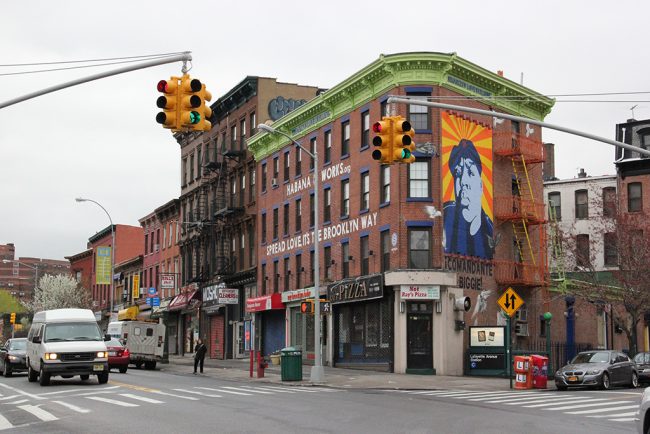
Fort Greene, Brooklyn | Photo by Daniel Rojo
Afro-Caribbean music is blasting from a building across the street, mixed with sounds of passing cars and children laughing as they use a building’s handrail as a limbo bar. Crowds stream in and out of Atlantic Terminal — one of New York City’s largest transit centers that, like others of its magnitude, also includes a small shopping mall with a handful of big-box stores. Women push strollers; two men point at the modern row house on the corner; an older Hispanic man walks by with an oversized boom box playing Roy Orbison’s “Pretty Woman.” Down the street on Hanson Place, neon signs announce the office of City Council member Letitia James, and up on South Portland Avenue, people snap pictures of a large mural of rapper and Brooklyn native Notorious B.I.G. It’s 6pm on a Friday in Fort Greene, and this is the street ballet outside of 80 Hanson Place.
80 Arts is a building brimming with arts organizations, including MoCADA, the Museum of Contemporary African Diasporan Arts, which prides itself on being recognized as Brooklyn’s “Town Hall institution for the discussion of complex topics that arise in a constantly evolving world.” Its storefront houses a shop and an exhibition gallery, while other programming extends out into the community, specifically Soul of Brooklyn, a consortium and block party series, and Public Exchange, which places arts programming in public housing.
MoCADA programs typify the cultural landscape in Fort Greene today, a place where an increasing number of arts organizations — among them Urban Bush Women, American Opera Projects, SONYA (South of the Navy Yard Artists), the Atlantic Avenue Association, StoryCorps, Franklin Furnace, and BRIC Arts Media Bklyn — simultaneously orient themselves to their local Fort Greene and Brooklyn communities while maintaining national and international audiences. The groups are part of a diverse tapestry and rich tradition of performing arts and culture-making in Fort Greene, much of which emerged from and continues to honor the longstanding local African American community. Composing that tapestry is an informal jazz culture, the more than 125-year heritage of the venerated Brooklyn Academy of Music, and a vibrant, self-generated arts scene that emerged in the 1980s and ‘90s, among others.
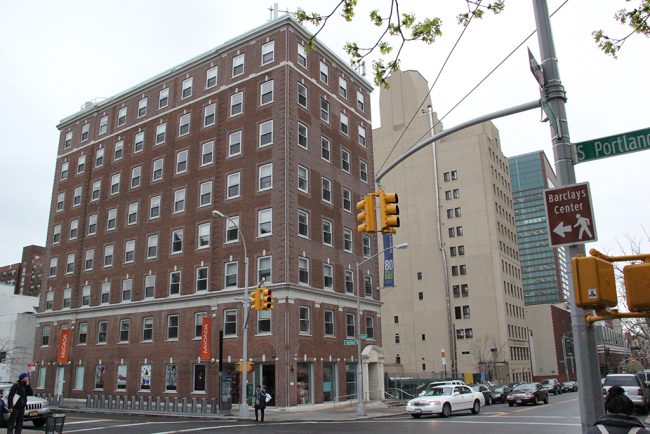
80 Arts | Photo by Daniel Rojo
In recent years, Fort Greene has seen already high property values climb even higher, pushing some residents out and threatening organizations that are struggling to sustain themselves. Yet three key locations have emerged to form a backbone of support for the local cultural community: 80 Arts, South Oxford Space, and the complex of buildings that is the Brooklyn Academy of Music. These three hubs are thriving, thanks in part to the backing of city politicians, developers, and other powerful interests who have recognized the area’s potential as a focal point for Brooklyn’s, and New York City’s, arts and cultural life.
“Times change, property value goes up and down,” hip-hop artist Talib Kweli says in Brooklyn Boheme, a 2011 documentary by Nelson George that explores the African American artistic community in Fort Greene during the 1980s and ‘90s. “You have to really be active in your community — doing things — to offset this, and to benefit from the new stores and new situations that come into the community. And that includes standing up for people who are displaced, who can’t afford to live here anymore.”
It is in this spirit that Laurie Cumbo founded MoCADA in 1999 and later initiated Soul of Brooklyn, a consortium of 32 community stakeholders composed of artists, arts organizations, and local businesses. “Soul of Brooklyn Block Parties are meant to concentrate Brooklyn’s artistic energy in a single place at a single time, in order to bring people together and foster interactions between artists and the community as a whole,” says James Bartlett, MoCADA’s executive director. “What better way to increase vibrancy in our community than to showcase this renaissance in the streets and the businesses that people frequent every day? Rather than expecting people to adapt their lives to the arts, we bring the arts right to the people.”
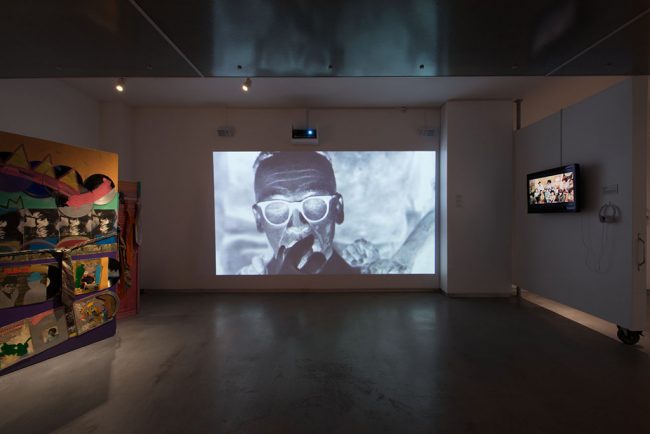
eMERGING: Visual Art & Music in a Post-Hip-Hop Era at MoCADA | Works by Modou Dieng (left), Pieter Hugo (center) and dream hampton (right) | Photo by Hiroki Kobayashi, 2013.
The African diaspora that MoCADA serves has a long history in Brooklyn, but spiked following the Harlem Renaissance of the 1920s. Upper Manhattan’s black population began to migrate to Brooklyn with the help of a new subway line that connected Harlem to Bedford-Stuyvesant that opened in 1936, as well as a new demand for workers at the Brooklyn Navy Yard during World War II. Not just New Yorkers, but southern blacks fleeing the Jim Crow South also moved to the area seeking work. Many of them settled in the northern parts of Fort Greene and Clinton Hill, just south of the Brooklyn Navy Yard, neighborhoods which historically were home to the area’s black population.
It was during this period of extreme growth that several public housing projects were built, all of which stand today. After World War II ended, many of the area’s new industrial workers either left or fell on hard times, and the Navy Yard was officially decommissioned in 1966, right in the middle of a 25-year period when the city’s industrial employment dropped by 49 percent. Some residents hunkered down through what would be one of the most difficult periods in Brooklyn — and all American cities — an era notorious for the top-down urban renewal programs implemented once it became clear that abandoned cities could no longer afford to maintain themselves. From 1970 to 1980, Brooklyn lost 371,000 residents, the greatest one-decade decline in its history. It was during this period that public housing developments became widely segregated and isolated from their surrounding communities and took on the poor reputation that persists today — a reputation MoCADA would like to change.
“The Public Exchange program aims to break down the invisible walls in the community,” says Bartlett. “Public housing is a part of Fort Greene, but it’s on the north side of the park, so it’s separated by a physical divide, a socio-economic divide.” Through film screenings, performances, and more, MoCADA hopes the program will “bring people that aren’t part of public housing into public housing,” says Bartlett. “To experience art and to experience people and life in normal context as opposed to a context of otherness.” This is for both populations, he says: “for people in public housing to feel like part of their community as well, on this side of the park — to come visit the museum.”
In fact, black residents in Fort Greene have long worked to form the area into a supportive community. In the late 1960s, civic groups and block associations were established to support the people, businesses, and real estate values that would make neighborhoods more appealing to new residents, both black and white. In Brooklyn Boheme, Nelson George contends that many of the area’s new homeowners were “jazz musicians who could afford the mortgages and loved the proximity to the jazz clubs of [the] West and East Village.” Indeed, the Central Brooklyn Jazz Consortium was established in 1958, and in 1969, bassist Bill Lee moved to Fort Greene with his family, including his young son Spike Lee. Though a cultural presence already existed in the neighborhood — Richard Wright, for example, famously wrote Native Son in Fort Greene in the late 1930s — this convergence of a larger artistic community was new for the area.
While it struggled economically, Fort Greene’s cultural roots grew deeper. Atlantic Antic, an annual street festival running along a major central Brooklyn corridor — and the southern border of Fort Greene — kicked off in 1975, and in 1977 the first DanceAfrica Bazaar was held outside of and in cooperation with the Brooklyn Academy of Music (BAM), which had recently undergone a significant revitalization under the leadership of new president Harvey Lichtenstein. Both street festivals continue to this day. In 1978, the BAM and Fort Greene historic districts were established.
Something had shifted. “Brownstone Brooklyn’s deindustrialized landscape was a layered landscape that retained imprints of previous eras of economic structuring,” Suleiman Osman says of this period in his 2012 book The Invention of Brownstone Brooklyn. “This palimpsest of empty factories, waterfront piers, and Victorian townhouses was a repository of symbolic value for white-collar enthusiasts, black power activists, white ethnic homeowners, and a variety of neighborhood groups.”
These different groups all met in the neighborhood in the early 1980s, where a set of young, college-educated artists, writers, and more were drawn, almost magnetically, to Fort Greene. Some came for the jazz music scene in the area — Frank’s Cocktail Lounge, once a jazz polestar, opened in 1974 — and some came just because it was the place to be. They bumped into each other on Fort Greene streets, partied together, and collaborated on projects, some of which were centered around Spike Lee’s movie production offices in a firehouse on the southwest corner of Fort Greene Park. Lee’s first film, She’s Gotta Have It, was set in the neighborhood and released in 1986. It was an instant hit.
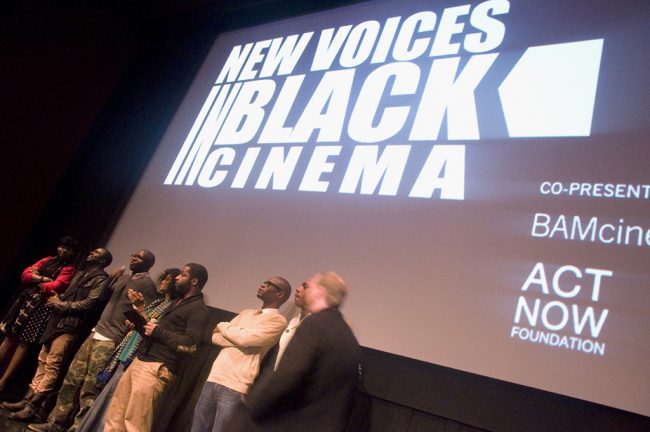
New Voices in Black Cinema 2013 | Courtesy of ActNow Foundation/New Voices in Black Cinema, photo by Jason John
The success of Lee’s films brought more young people to the area, but by that point, a performing arts scene had developed in its own right, and the informal jazz community was still thriving. In 1983, BAM’s Next Wave Festival was founded and featured several Brooklyn artists. And small theater groups began springing up, such as Rodeo Caldonia High-Fidelity Performance Theater, a now-defunct all-female group that employed both feminist and black power rhetoric; today, its members continue to influence culture in Fort Greene, and some are residents. “The history of Fort Greene black arts,” George says in his documentary, “is defined by communities within the community: the jazz musicians, Spike’s filmmaking team at the firehouse, Rodeo Caldonia, the Brooklyn Moon Cafe, and other musical collectives.”
The Brooklyn Moon opened in 1994 on the main strip of Fulton Street, where it remains, and became a hotbed for up-and-coming spoken word performers like Erykah Badu, Mos Def, and Saul Williams. Still others performed at BAMCafé Live, which began showcasing performances in 1999, a year after BAM’s Rose Cinemas opened. “When the cinemas opened, it changed everything,” said Tamara McCaw, Director of Government and Community Affairs at BAM. “For us it changed who was coming here, it made it much more local.” Through the years, BAM has acted as a partner to local organizations in varying levels, but it wasn’t until 2005 that it conducted a community engagement study to evaluate the needs of arts and culture around the institution and how it might leverage its assets to serve the local milieu. The study was done following the formation of the BAM Local Development Corporation (LDC), which began to seek opportunities to grow the area around the academy into a cultural center.
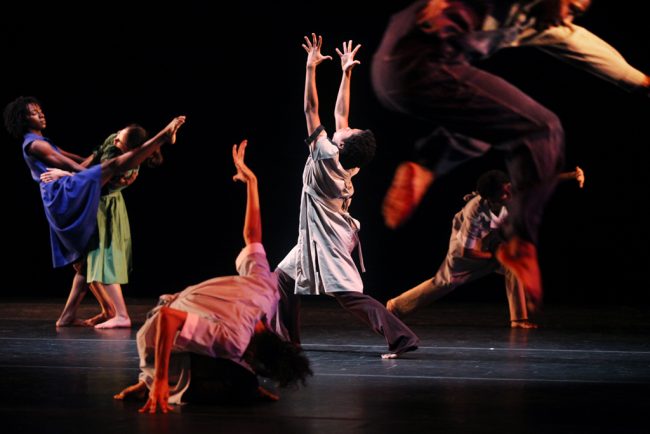
BAM Next Wave Festival | Photo by Julieta Cervantes, courtesy of BAM
Though they had been increasing already, Fort Greene property values skyrocketed after 1999, and most artists were priced out of the area. What’s more, according to the 2010 census, the black population in Fort Greene and Clinton Hill dropped by 31.4% from 2000 to 2010: in 2000, blacks made up 65% of the population, and in 2010 they made up 47%. In 2000, as potential development plans were being drawn up by the BAM LDC, The New York Times reported, “Some community leaders in Fort Greene, the neighborhood next to the academy, are worried that [new development design] ideas will clash with the neighborhood’s brownstone architecture. Business owners who have helped usher in an African-American renaissance along Fulton Street worry about being left out of the project. Rents have already shot up in Fort Greene in recent months, and some black residents fear that the project will make the neighborhood whiter.”
During this shift, in 2000, South Oxford Space (SOS) opened. SOS is an arts-supportive building managed by the Alliance of Resident Theaters New York (ART-NY), today home to 20 arts organizations, most of them theater companies or other groups centered around the performing arts. The building was purchased and renovated with help from major funders, as well as the City and State of New York, an approach that inspired the development of 80 Arts, MoCADA’s home. BAM LDC, chaired by Harvey Lichtenstein (former president of BAM), was in charge of overseeing the creation of 80 Arts, which opened in 2006. “The corporation received $1 million from the state and $5 million from the city to buy and renovate the red-brick building,” according to a New York Times article in January 2003. It continues, “Jeanne Lutfy, president of the development corporation, said, ‘There is a tremendous need for affordable offices for small arts groups, many of which work out of their living rooms.’ The offices will enable the groups ‘to do business better and foster collaborations,’ she said.”
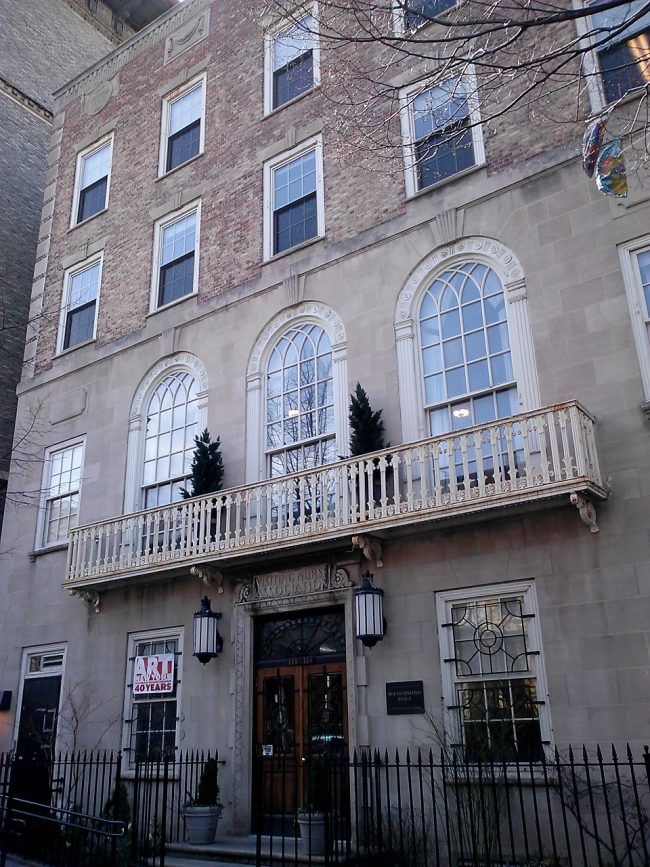
South Oxford Space | Photo by Mercedes Kraus
The lovely if unassuming SOS hub at 138 South Oxford Street, just two blocks from 80 Hanson Place, quietly buzzes with rehearsal sounds and arts administration conversations. Even over the rickety sounds of the original, elegant elevator, voices float down the stairwell and through open office doors. In the Great Room on the second floor, a group of dancers rehearses with large animal puppets.
On the fourth floor, Urban Bush Women (UBW) operates a nonprofit dance company. “It feels like a family here,” interim director Maria Bauman said of SOS, “to be in a community with other arts organizations and individuals who share this space with us. But there’s a larger community in Brooklyn that we’re really excited to be engaged with.” Like MoCADA, UBW puts community at the center of its mission. “Recognizing place matters” is a core value, part of the organization’s pursuit of “activating the intersections of professional and community art-making, civic engagement, leadership, and group dynamics.” To this end, it runs the Builders Organizers and Leaders through Dance (BOLD) program, a summer leadership institute, a culture and community series called Being Bushified, and a weekly class at neighboring Cumbe: Center for African and Diaspora Dance. In the SOS Great Room, UBW hosts film screenings, dance workshops, and more. They’ve connected with Cooperative Culture Collective to work on that organization’s annual Juneteenth festival in Cuyler-Gore Park, which, Bauman says, “has a lot to do with creative place-making and outdoor events that celebrate that African-American tradition.”
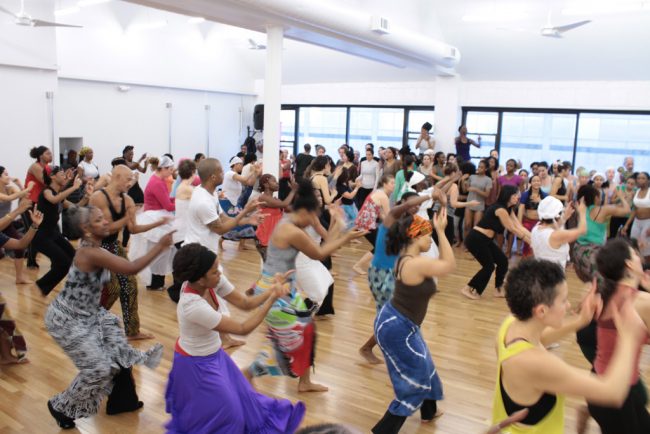
Cumbe Grand Opening Dance Class | Photo by Josh Gilbert, courtesy of Cumbe Dance
Both Urban Bush Women and MoCADA have partnered with countless numbers of local groups to create community-centered programming. The BAM Community Affairs department lists 363 community contacts in the zip codes that make up Fort Greene, though of course the actual number of cultural producers is much higher than that. In fact, it’s nearly impossible to determine the exact number of arts and culture organizations in the area. “I don’t know if there’s ever a number you can put on that,” says BAM’s McCaw. “Because there are people that are working in formalized roles, like non-profit or business — but then there are entrepreneurs, there are cultural entrepreneurs. And the mixing of art and enterprise produces individual collectives of people doing really amazing work. You just could go on and on. And on. But that’s what makes it great.”
These culture-makers exist in a zone that is increasingly referred to as the BAM Cultural District, which is overseen by local development corporation Downtown Brooklyn Partnership (DBP). DBP is focused on making City-owned properties into affordable spaces for arts groups, and it maintains a map of the greater downtown area of Brooklyn — including the western portion of Fort Greene — showing completed, in progress, and planned development, arts-related or otherwise. DBP notes that plans for the area are informed not only by local stakeholders but also by the Bloomberg administration. How these growing development interests will affect the area is yet to be known, though the neighborhood already has seen its share of development-related controversy, including around the new Barclay’s Center. But Fort Greene’s most recent history is a lesson in how a cultural community can leverage its legacy of artistic production in the face of intensifying real estate pressure and outside influence and interest, and thereby both honor and benefit its local audience.
The views expressed here are those of the authors only and do not reflect the position of The Architectural League of New York.
What happens when cultural uses cluster and creative practitioners collaborate in the service of their neighborhoods.

Comments